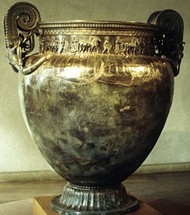Iron Age Art
![]()
History of Art Timeline -
Prehistoric Art Timeline
Prehistoric Art - Earliest
Art of the Stone Age - Oldest
Art
|
Iron Age Art |
|
ANCIENT ARTS AND
CULTURES |
Iron Age Art (c.1100-200 BCE)
|
 The Vix Krater (c.500 BCE) Wine-mixing vessel discovered in the famous grave of the "Lady of Vix" in Burgundy. It is the largest known metal vessel of antiquity. |
|
For more about architectural visual |
Only after Greece began to lose its power at the end of the Iron Age (c.200 BCE onwards) did Roman art begin to appear, and this was created largely by Greeks in the Hellenic style. Unfortunately, many of the paintings and other artworks from this period have been destroyed, leaving us with only a relatively small legacy of architectural and portable art works (like vases) by which to gauge the artistic activity of the day. In the history of art, Mediterranean Iron Age civilization is classified into several smaller periods, most of which reflect the artistic activity in Greece. These are: the Dark Ages (c.1200-900 BCE), the Geometric Period (c.900-700 BCE), Oriental-Style Period (c.700-625 BCE), the Archaic Period (c.625-500 BCE), the Classical Period (c.500-323 BCE), and the Hellenistic Period (c.323-27 BCE). |
|
DIFFERENT
FORMS OF ARTS |
|
During the Dark Ages, the Greek world temporarily fell into chaos due to external pressures. The smaller, poorer constituent kingdoms which emerged could not support the luxury arts that had flourished in the Bronze Age palaces of the Minoan and Mycenaean empires. Most painting and sculpture were lost and the arts went into decay. Fortunately, by 900 BCE, Athens reasserted itself and the arts - notably ancient pottery (painted vases) - regained their earlier importance. During the Geometric Period, vases were produced in geometric shapes to facilitate maximum decoration and narrative. During the Orientalist Period, vases became less geometric, and depicted more heroic scenes from Greek history. See also Daedalic-style Greek Sculpture. During the Archaic period, these historical motifs were initially replaced by stereotyped animal or human figures, although by 500 BCE even more complex mythological scenes had reappeared. See Archaic-style Greek sculpture and Archaic-style Greek painting. Throughout the first four periods of the Iron Age, vase painting largely mirrored monumental art - meaning, painting and decoration of buildings and other monuments. Many temples and other public buildings were decorated with friezes and wall-paintings. During the Classical Period, Greek art became less decorative and more dignified. Painting depicted political and military successes. Noted muralists of the time included Polygnotus, Micon, Apollodorus (invented skiagraphia or shadow-painting), Zeuxis, Apelles, and Parrhasius. Both linear-style and more subtle shading styles were practised. Sculpture, relief, pedimental and free-standing, was more widespread and has survived better. Art historians sub-divide the sculpture of this era into Early Classical, High Classical and Late Classical varieties. The Hellenistic Period, beginning with the death of Alexander the Great, witnessed more developments in both Greek painting and sculpture. Artists became employed by rulers who utilized their talents to promote their image and secular claims. As Rome gained in political power, Etruscan art began to recover from its domination by Greece. Remains of tombs in Etruria display paintings with quite sophisticated chiaroscuro effects. Iron Age arts in Northern and Central Europe owed much to the influence of Celtic metalwork art, but remained limited in design and quality by comparison with Mediterranean examples. By far the best examples of central European civilizations include the Hallstatt and La Tene styles of Celtic culture. Few secure cities emerged in the North during this time, leaving fewer opportunities for painting and sculpture. Instead, art was limited to personal adornments, cooking or drinking vessels, along with decoration and ornamentation of weaponry, horse tack, boats and other functional items. (For more about Celtic crafts in Ireland during this period, please see the history of Irish art.) In Chinese art, the end of the Iron Age witnessed the supreme example of ceramic art in the form of the huge collection of terracotta sculpture, known as The Terracotta Army. (c.240-210 BCE), which was followed by four centuries of Han Dynasty Art (206 BCE - 220 CE). |
|
• For the main index, see: Homepage. ENCYCLOPEDIA OF ANCIENT ART |